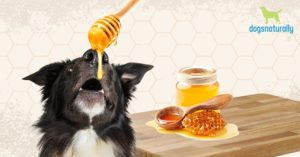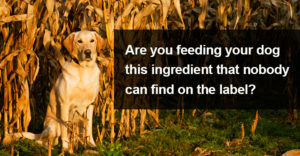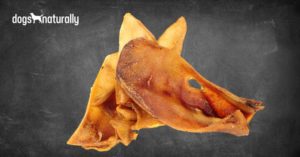I want you to look at the following skull pictures from two different animals. Because a lot of people raw feeding dogs aren’t giving them a species appropriate diet …
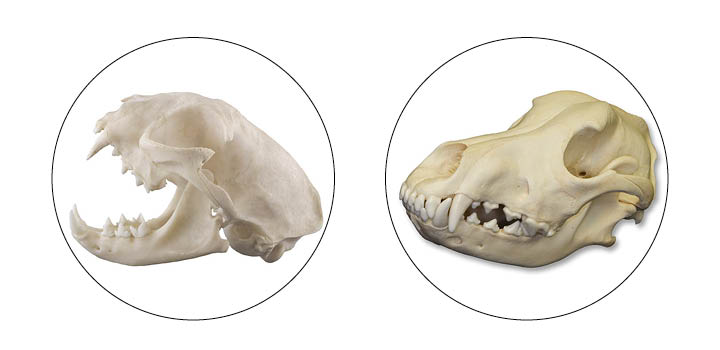
Look at the difference in the shape and number of teeth. Do you think these animals should be eating the same foods? Clearly, these are different animals with different needs. In fact, they’re about as different as cats and dogs.
If you haven’t guessed already, the skull on the left belongs to a cat and the skull on the right belongs to a dog. And these skulls show just some of the differences in dogs and cats … so I want to talk about how that should determine what we feed them.
Why do we need to talk about this?
A New Look At The Species Appropriate Diet
It doesn’t matter whether you feed your dog BARF, prey model, species appropriate or any other type of raw diet … there are lots of ways to play and most all of them are better than feeding processed diets.
The goal of most raw diets is to feed our dogs what Mother Nature intended your dog to eat. This is why we often model their diet after their closest wild relatives, the wolves. And that’s a really good idea.
But the problem is, most raw feeders aren’t feeding their dogs like wolves (or even dogs) at all … they’re feeding them like cats! Let’s look at why that could be a mistake.
What The Mouth Tells Us About Diet
See those pointy teeth that both dogs and cats have? They’re called canine teeth and they’re meant to tear and rip flesh. In fact all of the teeth of the dog and the cat are pointy, so that fact, in addition to the pronounced canine teeth, is a good indication that they’re both meant to eat meat. They’re both carnivores.
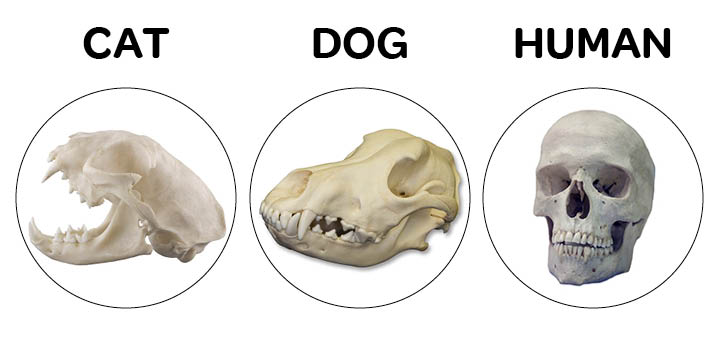
Let’s compare that to our own omnivorous teeth!
We don’t have those long, sharp canine teeth. And if you look at the back of our mouth, you’ll see the molars are flat. The job of the molars is to crush and grind plant matter. This is why we’re classified as omnivores … our teeth tell us we have adapted really well to eating plant matter.
Now let’s look again at the teeth of the dog. You can see they also have lots of molars at the back of their mouth and they’re not as sharp and elongated as the cat’s molars but not as flat as our human molars.
So the dog’s mouth is somewhere between the human mouth and the cat’s mouth.
Amylase: A Moot Point
There’s something we humans have in our mouth that neither dogs or cats have … something called salivary amylase. Amylase is an enzyme that breaks complex carbohydrates down into simple sugars.
Try this experiment … hold a piece of bread in your mouth for a few minutes and you’ll notice it starts to taste sweet. That’s amylase converting that bread into sugar.
Neither cats or dogs have salivary amylase. That makes a lot of raw feeders think that dogs can’t digest plant matter. This simply isn’t true.
Because amylase also lives in your dog’s pancreas. Dogs have about 20 times more pancreatic amylase than cats … and the activity of the enzyme rises in dogs with the level of starch content in the diet. This means dogs can digest over 99% of processed starches and about 90% of many raw starches. The cat’s ability to digest starch is more limited (1).
If we move down the digestive tract, you’ll see even more fundamental differences between the dog and cat.
Dog vs Cat Digestive Tracts
The human digestive tract averages 30 feet in length. Our appendix is actually the remnant of a fermentation system in the large intestine, from when we ate a more herbivorous diet.
- The average length of the dog’s digestive tract is 2 feet.
- The average cat’s digestive tract is 13 inches – just over half the length of the dog’s.
Here are a few more differences between the digestive systems of dogs and cats.
Humans (as well as other omnivores and herbivores) can easily convert plant based ALA (Alpha-linolenic acid), which is a type of omega-3 fatty acid found in plants, to its useful constituents, EPA and DHA.
- Dogs can convert approximately 5 to 15%.
- Cats completely lack the enzymes necessary for this conversion.
And finally, dogs can manufacture taurine (an amino acid from animal protein), whereas cats can’t. Here are some other differences between cats and dogs:
Cats
- Shorter snout (means more crush force)
- Can’t produce taurine (must get it from animal protein)
- Regulate blood sugar with protein
- Enzymes for protein breakdown are always active
- Can’t convert plant-based beta carotene to vitamin A
- Can’t convert linoleic acid to arachidonic acid (2)
- Don’t have the enzymes hepatic glucokinase and hepatic glycogen synthesase – that convert nutrients from carbohydrates
- Produce 20 times less pancreatic amylase than dogs
- Can’t convert alpha-linolenic acid to eicosapentaenoic acid (EPA) and docosahexaenoic acid (DHA) (2)
Dogs
- Longer snout
- Can produce taurine
- Regulate blood sugar with carbohydrate
- Protein-digesting enzymes are only active when there’s protein in the diet
- Can convert plant-based beta carotene to vitamin A
- Can convert linoleic acid to arachidonic acid (2)
- Have the enzymes hepatic glucokinase and hepatic glycogen synthesase to convert nutrients from carbohydrates
- Produce 20 times more pancreatic amylase than cats
- Can convert alpha-linolenic acid to EPA and DHA (2)
The cat’s enzymes and physiology tell us that cats must eat a meat-based diet … but clearly, dogs are much better adapted to getting nutrition from plant sources.
But does that mean the dog should eat plants? Let’s take a look …
What Do Wolves Eat?
Most scientists report very little plant matter in wolf scats and many raw feeders will take that to mean wolves don’t eat plant matter. But the problem is, most wolf scats are analyzed in the winter months when it’s easiest to track them … and there isn’t much in the way of berries and vegetation in the winter months!
When wolf scats are analyzed from the summer months, we see something different (3). What we see is a diet that contains 8% grasses and berries. And some studies show as much as 20% plant matter in the wolf diet.
Stadler et al also found that 74 percent of wolf scats collected in the summer contained plant matter (4)
American wolf expert David Mech notes that wolves in Italy, where fruit is more available, have been shown to eat cherries, apples, plums, figs, pears, grapes and even melon. Wolves in all regions also consume grasses. Many believe this is to prevent parasites but Mech believes the reason may be for the vitamin content. (5)
So plant matter is a small but significant part of the wolf’s diet. Most studies show that cats also eat plant matter but obviously their diet is different than that of the wolf.
In a 2007 French study, 25% of wild cats had plant matter in their scats, and another showed a higher percentage (6). But what’s interesting is the vegetation isn’t fruit and berries: it’s grasses and twigs, which are indigestible to the cat (and any species that isn’t a herbivore). Because cats can’t digest grasses and twigs, they’re eating it for reasons other than nutrition.
The digestive tracts and enzymes are different in cats and dogs and the dietary habits of wolves and wild cats also differ.
So research, anatomy and physiology tell us the cat is a true carnivore … while the dog is a little more arbitrary in his eating habits and can convert plants into fuel and nutrition. Not quite as well as humans can, but certainly they are much more adaptable in their diet than the cat. And that leads me to my main point …
Taxonomy: How We Group Animals
Animals (and plants) are grouped by scientists according to their description and identification.
Dogs and cats are both from the order Carnivora (meaning they are carnivores). Carnivore diets are mainly made up of meat. But the order Carnivora splits into several groups and dogs and cats don’t share the same taxonomy.
Cats, including most wild cats share the same taxonomy, Felis. They all share the same traits, ancestry and physiological makeup. All members of the felid family are obligate carnivores. Obligate carnivores must have meat as the mainstay of their diet or they can’t thrive. And this makes sense looking at the diet of cats … which is a lot of meat and some grasses and sticks.
Dogs and wolves share the Canis classification. Their needs are different than the cat and we can see these differences in the ancestry, their anatomy and their physiology. Members of the Canis family are facultative carnivores. This means they are carnivores with omnivorous tendencies.
And this makes sense because dogs are much better scavengers than cats … they can thrive on a wider variety of foods and the wild dog’s diet shows a greater willingness to eat berries and fruits.
Are You Feeding Your Dog Like A Cat?
Have you ever heard of a “prey model” or “species appropriate” diet?
The premise is that you should only feed your dog animal products and that plant matter has no place in their diet.
This concept is pretty ironic … because now that we’ve compared the dog to the cat, feeding nothing but animal based products may be a species appropriate raw cat diet, but it’s clearly not a species appropriate raw dog diet!
You’re feeding your dog cat food.
If you want your dog’s diet to be species appropriate, you need to better understand the species! And I hope this has helped.
So … based on anatomy, physiology and research, the dog’s diet should include a small amount of berries and plant matter. Anything else isn’t species appropriate. But there’s a disclaimer on that …
Don’t Start Feeding Those Carbs Just Yet …
Now if you’re looking to feed your dog kibble or a diet with lots of starchy carbohydrates (like kibble or other processed diets) … don’t! Most kibbles and cooked diets are 30 to 60 percent starch or carbohydrates.
While wolves are eating plant matter, it’s not starch. It’s not potatoes, it’s not rice and it’s not corn. So why are you feeding it to your dog?
In nature, the wolf or wild dog would eat, on average, 4 to 7% carbohydrates. And we know that most of that would come from plants and fruits, not grains.
Dogs (and people) have 8 hormones that raise blood sugar and only one to lower it (insulin). They’re made to live in a world with very little starch and on the rare occasion they’ve eaten too much, then that one hormone is there to lower it.
The other seven hormones are there to raise blood sugar because starch is not normally a large part of the diet. Animal nutrition researcher Richard S Patton PhD says feeding dogs kibble constitutes literal hormone abuse.
So while dogs clearly have the teeth, digestive tract and physiology to eat plant matter, you need to stick to what they’d eat in the wild if you really want to feed a species appropriate diet. And that means 4 to 7% plant matter … and it definitely shouldn’t include starches your dog wouldn’t find in the wild, like corn, sweet potatoes or rice.
The Takeaway
I can’t tell you what to feed your dog. But I can tell you that if you’re feeding a meat-only diet, it’s not species appropriate!
In fact, if you’re not feeding hair, feathers, eyes, brains and other icky parts, you’re not feeding a species appropriate diet either … and your dog will be lacking in many important vitamins and minerals. Your dog needs to eat skin or he will likely be vitamin D deficient. Your dog needs to eat wool, hair or feathers or he will probably be manganese deficient. And so on …
Are you feeding all of the animal parts to your dog? Most people aren’t … so that means your dog’s raw diet (including some commercial raw diets, but not all), is probably deficient.
In light of that, wouldn’t it be a good idea to throw just a few fruits and grasses at him to help make up for this? You won’t solve all of his deficiencies but it’s certainly a start.
And best of all, you’d be feeding him an actual, species appropriate diet.
References
- Nutrient Requirements Of Dogs And Cats. National Research Council. 2006.
- Jean Hofve DVM. Omega fatty acids for dogs and cats. IVC Journal. October 26 2018
- Sabrina Müller. Diet composition of wolves (Canis lupus) on the Scandinavian peninsula determined by scat analysis. School of Forest Science and Resource Management, Technical University of Munich. July 2006.
- Stahler DR, Smith DW, Guernsey DS. Foraging and feeding ecology of the gray wolf (Canis lupus): lessons from Yellowstone National Park, Wyoming, USA. J Nutr. 2006 Jul;136(7 Suppl):1923S-1926S.
- L David Mech, Luigi Boitani. Wolves: Behavior, Ecology, and Conservation. Univ Chicago Press. 2003.
- E. Bonnaud, K. Bourgeois et al. Feeding Ecology of a Feral Cat Population on a Small Mediterranean Island, Journal of Mammalogy, Volume 88, Issue 4, 20 August 2007, Pages 1074–1081.







